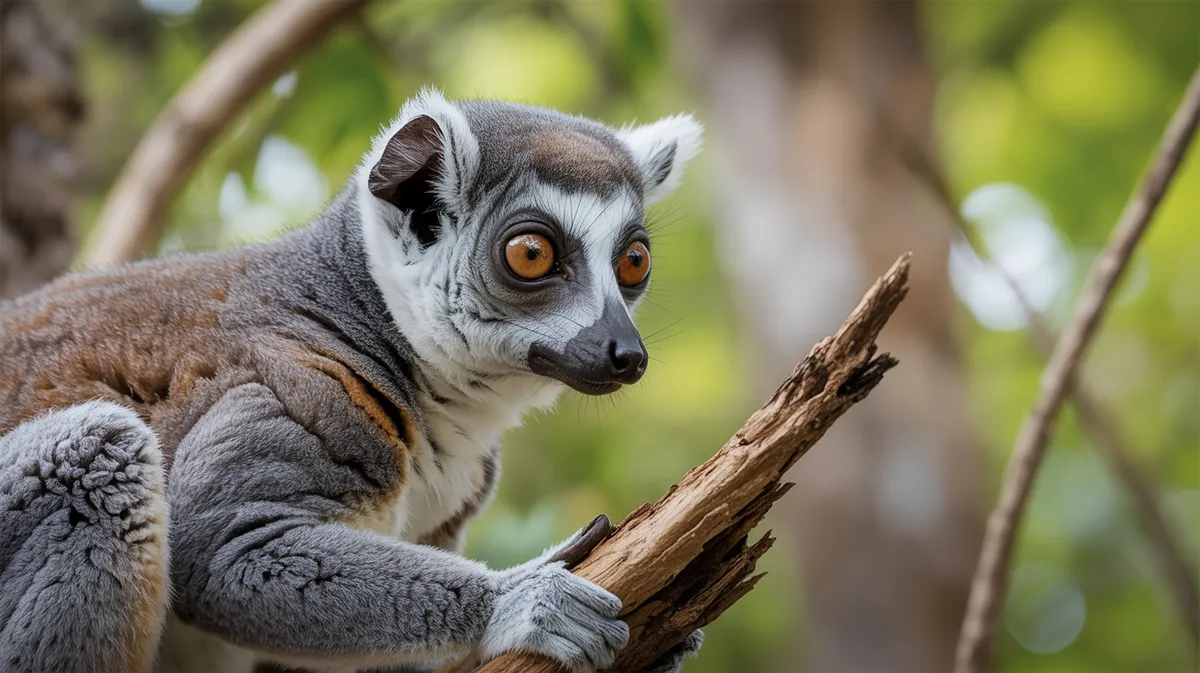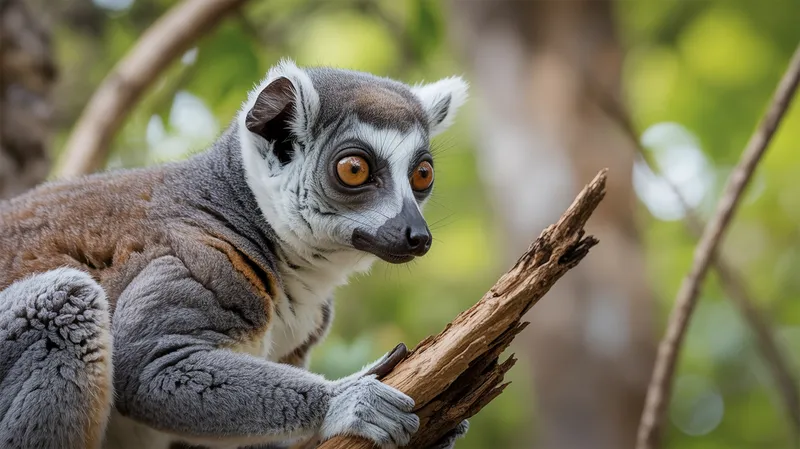
Northern Sportive Lemur
Lepilemur septentrionalis

Meet the Northern Sportive Lemur
The Northern Sportive Lemur is a small, nocturnal primate native to the dry forests of northern Madagascar. Distinguished by its large, round eyes and woolly gray-brown fur, this lemur is highly adapted to an arboreal lifestyle, leaping between branches with agility. It is solitary by nature, spending daylight hours resting in tree hollows and emerging at night to feed. Due to severe habitat loss and fragmentation, the Northern Sportive Lemur is considered one of the world’s most endangered primates.
Classification
Mammal
Habitat
Dry deciduous forest
Diet
Herbivore
Lifespan
8-12 years
Conservation
Critically Endangered
Weight
0.7-1.0 kg
📖Fascinating Facts
Nocturnal Lifestyle
Northern Sportive Lemurs are active only at night, spending their days sleeping in tree hollows or dense foliage to avoid predators.
Leaping Ability
They possess powerful hind legs, allowing them to leap distances up to 5 meters between trees in search of food.
Leaf Eaters
Their diet primarily consists of leaves, but they also consume flowers and fruit when available, relying on specialized teeth to break down tough foliage.
📋Detailed Description
The Northern Sportive Lemur (Lepilemur septentrionalis) is a small, nocturnal primate with a head-body length of approximately 22–28 cm and a tail length of 24–29 cm, weighing between 0.8 and 1.2 kg. Its dense, woolly fur is generally grayish-brown dorsally with paler underparts, providing camouflage in the dry, deciduous forests of northern Madagascar. The species is characterized by large, forward-facing eyes adapted for nocturnal vision, and a reduced dental formula typical of the family Lepilemuridae. Its hands and feet are well-adapted for grasping branches, featuring opposable thumbs and elongated hind limbs that facilitate powerful vertical leaping between trees. The ears are relatively small and rounded, aiding in sound localization at night. This lemur is primarily arboreal, rarely descending to the ground, and spends daylight hours concealed in tree hollows or dense foliage. It is a solitary forager, with individuals occupying overlapping home ranges of 0.5–1.5 hectares. The species is folivorous, feeding mainly on young leaves, buds, and occasionally fruit or flowers, utilizing a large cecum for fermenting fibrous plant material. Vocalizations are used for territory defense and communication, and scent-marking is common for maintaining spatial boundaries.
💡 Did you know?
There may be fewer than 100 Northern Sportive Lemurs left in the wild, making them one of the rarest primate species on Earth.
🔬Research & Sources
Wikipedia Summary
The northern sportive lemur, also known as the Sahafary sportive lemur or northern weasel lemur, is a species of lemur in the family Lepilemuridae. It is endemic to Madagascar. As a result of severe ecological and human pressures, the lemur is classified as Critically Endangered (CR) by the IUCN Red List.
Last Modified: 12/14/2024
🎭Behavior & Social Structure
Northern Sportive Lemurs are strictly nocturnal, emerging at dusk to forage and returning to their daytime refuges before dawn. Their activity is characterized by a pattern of short, intense feeding bouts interspersed with periods of rest and vigilance. They exhibit vertical clinging and leaping locomotion, moving rapidly between tree trunks and branches. Social interactions are limited, as the species is predominantly solitary, though home ranges may overlap, particularly between males and females. Communication is achieved through a combination of vocal calls—such as grunts and clicks—used to warn of predators or signal presence, and through olfactory cues, including urine and glandular scent-marking. They are highly territorial, with males especially defending core areas. Feeding behavior is selective; individuals often revisit specific food trees and display seasonal shifts in diet composition depending on leaf availability and quality.
👶Reproduction & Life Cycle
Reproduction in Lepilemur septentrionalis is seasonal, with mating typically occurring at the onset of the rainy season (November–December). Females exhibit a brief estrus period and are receptive for only a few days each year. After a gestation period of approximately 120–135 days, a single offspring is born, usually between March and April. Neonates are altricial, weighing about 40–50 grams at birth, and are initially carried in the mother's mouth or left in a secure nest while the mother forages. Maternal care is pronounced; the mother nurses and grooms the infant, which becomes increasingly independent after 2–3 months. Weaning occurs at around 4–5 months, and sexual maturity is reached at about 18–24 months. There is little evidence of paternal care, and reproductive rates are low, contributing to the species' vulnerability.
🛡️Adaptations & Survival
The Northern Sportive Lemur exhibits several adaptations for its arboreal, nocturnal lifestyle. Its large eyes contain a reflective tapetum lucidum, enhancing night vision. The elongated hind limbs and robust thigh muscles enable powerful leaps of up to 5 meters between trees. Specialized dentition, including a reduced dental comb, facilitates the processing of tough, fibrous leaves. The enlarged cecum and colon house symbiotic bacteria for fermenting cellulose-rich plant material, allowing efficient extraction of nutrients from a folivorous diet. Behavioral adaptations include cryptic resting postures and selection of concealed daytime refuges to avoid predation. Scent-marking and vocalizations are finely tuned for low-visibility communication in dense forest environments.
🎨Cultural Significance
The Northern Sportive Lemur holds limited direct significance in Malagasy folklore compared to other lemur species, but lemurs in general are often regarded with a mixture of reverence and superstition. In some local traditions, lemurs are seen as ancestral spirits ("fady"), which can afford them some protection. However, due to increasing poverty and food insecurity, traditional taboos are weakening, and hunting pressure has increased. There are no known traditional medicinal or utilitarian uses specific to this species.
🔬Recent Research & Discoveries
Recent research has focused on the genetic diversity and population structure of L. septentrionalis, revealing alarmingly low genetic variability due to small, isolated populations. Radio-telemetry and camera-trap studies have improved understanding of home range size, habitat preferences, and activity patterns. Conservation genetics work is ongoing to assess the feasibility of translocation or captive breeding programs. Ecological studies have highlighted the species' dependence on intact dry forest and the importance of specific tree species for food and shelter. There is active collaboration between Malagasy and international researchers to develop community-based conservation strategies and habitat restoration projects.
🎥Wildlife Videos

Getting Wild and Woolly!
This week we're out in the forest, sitting down with a family of Woolly Lemurs, one of the nocturnal lemur species of Ranomafana!
Life Gone Wild

Lemurs
Vocabulary about lemurs: words and articles.
V.Fox.English

10 Most Endangered Animals
10 Most Endangered Animals 1 Ivory-Billed Woodpecker A North American bird so endangered it may actually be extinct 2 Amur ...
The Vitality Chronicles

Top 10 Rarest Animals in the World
There are over 8 million animal known living animal species in the world. And yet, some are dying out at an alarming rate due to ...
Top 10 Clipz

Learning About Lemurs with Primatologist Patricia Wright - Martha Stewart
Primatologist Patricia Wright came on our radio show to talk about her work in Lemur habitat and population preservation in ...
Martha Stewart

Top 10 Most Endangered Animals | Top 10 animals
Top 10 Most Endangered Animals | Top 10 animals Top 10 Most Endangered Animals: 10. The little Dodo Bird 9. Chinese Giant ...
TOP 10 Animals
🌍Habitat Information
The Northern Sportive Lemur typically inhabits Dry deciduous forest environments. Northern Sportive Lemurs have adapted to their environments with specialized features and behaviors.
Primary Habitat:
Dry deciduous forest
More detailed habitat information will be available soon.
🛡️Conservation Status
The Northern Sportive Lemur is currently classified as Critically Endangered. Conservation efforts are crucial for preserving this species for future generations.
Common Threats:
- 🏠Habitat loss and fragmentation
- 🌡️Climate change impacts
- 🎯Hunting and poaching
- 🏭Human-wildlife conflict
⚠️Threats & Conservation Challenges
Lepilemur septentrionalis faces severe threats from habitat loss due to slash-and-burn agriculture (tavy), illegal logging, and charcoal production, which have fragmented its already restricted range. The species is also subject to hunting for bushmeat, despite legal protections. Its population is estimated at fewer than 50 mature individuals, making it one of the most endangered primates globally. Habitat fragmentation leads to genetic isolation and reduced reproductive success. Conservation challenges include limited enforcement of protected areas, lack of community engagement, and ongoing socioeconomic pressures on local human populations. Climate change and invasive species further exacerbate habitat degradation.
🔬Scientific Classification
Scientific Name
Lepilemur septentrionalis
Classification Hierarchy
🔍 About Taxonomic Classification
Taxonomic classification is a hierarchical system used by scientists to classify and organize living organisms based on shared characteristics and evolutionary relationships.
The system moves from broad categories (Kingdom) to increasingly specific ones, with each animal's scientific name typically consisting of its Genus and species.
📝Community Notes
Share your observations and insights about the Northern Sportive Lemur with our community of wildlife enthusiasts.
Join Our Community
Sign in to share your observations and connect with fellow wildlife enthusiasts.
Sign In to ContributeNo community notes yet
Be the first to share your observations about the Northern Sportive Lemur!
Explore Northern Sportive Lemur
Select a tab above to learn more about this amazing animal.
📸Photo Gallery
No photos available for this animal yet.
🌟Discover More Wildlife
Continue your journey of discovery with more fascinating animals from our database
